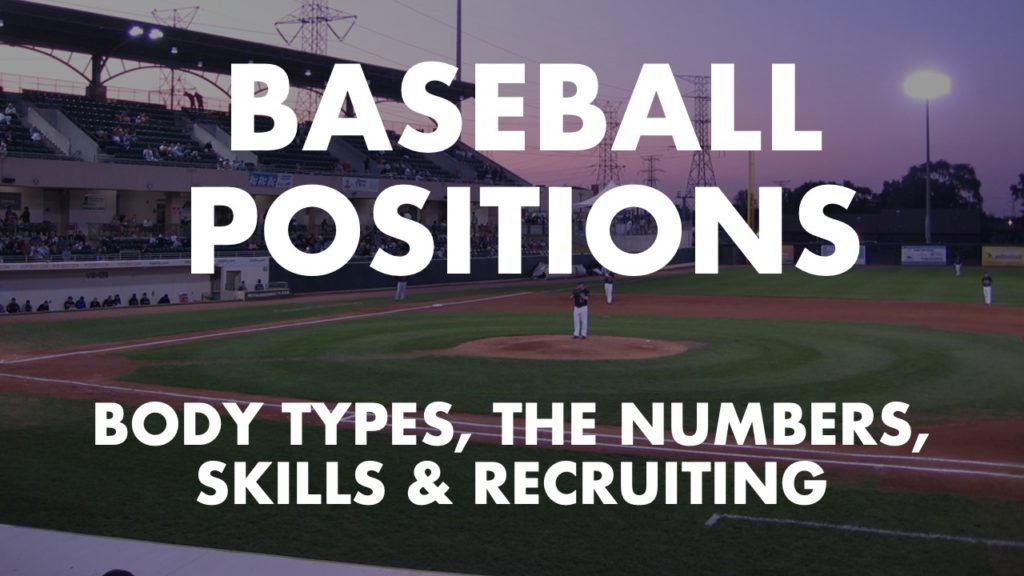*This article may contain product links which pay me a small commission if you make a purchase. Learn more.
What do the baseball position numbers mean? They are used in scoring the game, and so each position is designated with a 1-9 number. They go in order, starting with the pitcher as #1, however the shortstop is out of order–he should be #5 if following the pattern, but instead is #6.

This was because originally, the shortstop was the fourth outfielder. Later, the shortstop was moved permanently to the infield but his number stuck at #6. It’s important to understand the positional numbers so that a proper scorebook can be kept and players understand the lineup and dugout card.
Want to Learn More About The Rules of Baseball?
Watch my detailed video on baseball rules for beginners.
In this detailed article we’ll cover the position numbers, body types, skills and much more:
The table of contents below is clickable, so jump ahead and share this with a friend as a great reference. If you’re looking for more great baseball instructional videos, check out this article.
And, check out my new video that walks you through all nine positions:
Before we get going, if you’re trying to become the best ballplayer you can be, check out my new book, Clean Your Cleats. It’s written to help players become the best version of themselves and understand the game of baseball in a deeper way.
Part of being a great ballplayer is understanding which position will be best for you, so let’s get to it.
Skip ahead anywhere in the article using the table of contents below. And if you’re looking for a great pitching resource, check out my book below and subscribe to my baseball YouTube channel.

Skip Ahead anywhere in this article on baseball positioning.
We’ll start with the basics, answer a lot of questions and get to some more advanced topics on infield defense and recruiting at the end.
CHART: All Nine Baseball Position Numbers
Below is a standard baseball position chart that shows the number for each position.
- Pitcher (P) is fielder #1
- Catcher (C) is fielder #2
- First Baseman (1B) is fielder #3
- Second Baseman (2B) is fielder #4
- Shortstop (SS) is fielder #6
- Third Baseman (3B) is fielder #5
- Left Fielder (LF) is fielder #7
- Center Fielder (CF) is fielder #8
- Right Fielder (RF) is fielder #9
CHARTS: Basic Infield Positioning
There are a handful of main infield positioning charts that will help you with the visual of the baseball positions. It’s not enough to just know what they are, but how players should adjust based on different situations.
Basic Infield Position #1: Standard Depth
Standard infield depth is below, and what you’ll notice is that the second baseman plays a little deeper than the shortstop. The reason for this is that his throw is shorter, and thus he can play a little deeper and still have time to make the routine play. Here are the main things to know about standard positioning:
- The third and first baseman are never standing too close or too far from the line, and their proximity to home plate varies based on the perceived speed of the hitter.
- The shortstop will play pretty deep, but has to be mindful of the runner and his own throwing arm strength.
- The first baseman can play deeper than the third baseman because he’s close to first base, but in this “standard” defense both are shown in similar positions.
Basic Infield Position #2: “Infield In”
Infield in calls for infielders to position themselves on the infield grass where they can get a runner on third out at home plate if he runs on contact. Here are key things to know about infield in:

- This GREATLY reduces the range of infielders, so it should not be used in non-essential situations, because more routine ground balls and bloopers will fall in for hits
- Infield in Is typically used only late in games when the runner on third base CANNOT score – this means the runner is usually the tying or go-ahead run
- It is never used with two outs
- Bringing the infield in can also be used sparingly with a runner on third when there is not a big threat of a big inning
- Many youth coaches misuse infield in by over-using it
Basic Infield Position #3: Double-Play Depth
Double-play depth is different than the standard infield positioning in that middle infielders need to be closer to 2nd base so they can quickly touch the base and make the return throw to first. If the SS and 2B are too far from the base, they won’t get there soon enough to complete the double play.
Double plays happen only on medium or hard-hit ground balls, and a lot has to happen in a very short time.
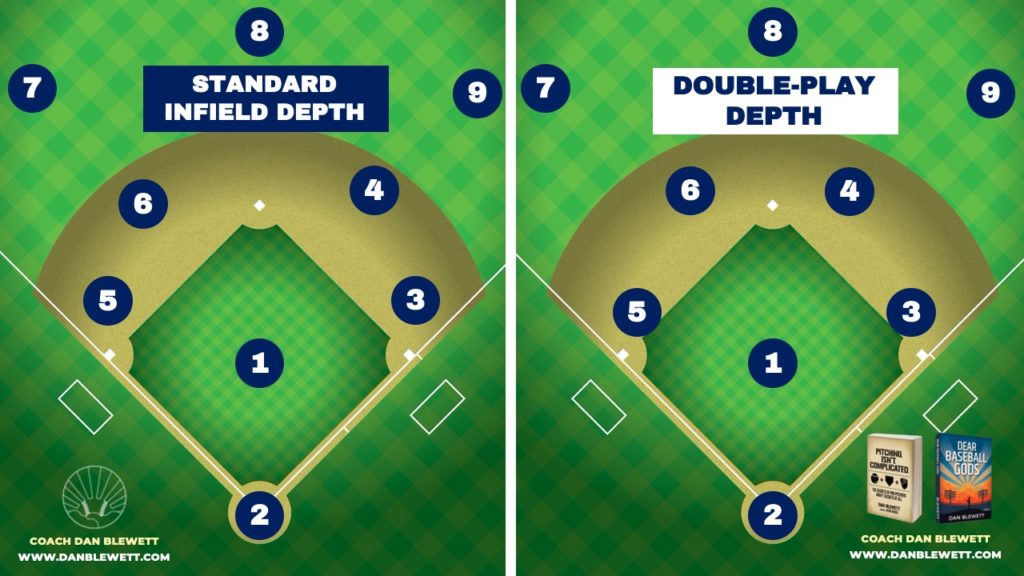
The corner infielders are typically even with the base so that they too can field a ground ball as soon as possible and get the double play started.
The first baseman will be holding the runner, so he will shuffle in front of the baseline once the pitcher delivers to home plate.
Advanced Infield Defense: Infield Halfway
To learn more about the infield halfway defense, go here for my in-depth article on infield positioning in baseball. This one is a bit more nuanced and warrants some explaining.
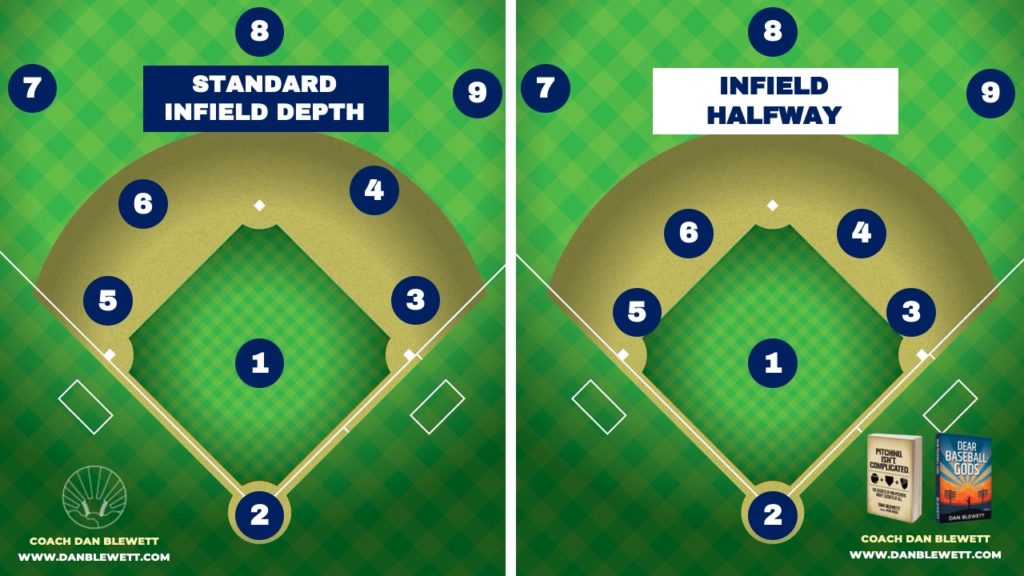
Remaining infield defenses mostly involve slight shifts to sensibly cut down tendencies by hitters in different situations.
Positioning for Lefties and Righties in Non-Force Out Situations
For more on how to shift left and right–and why–check out my article on advanced infield positioning – it goes deeper into when and why to shade and shift left and right depending on the hitter and situation.
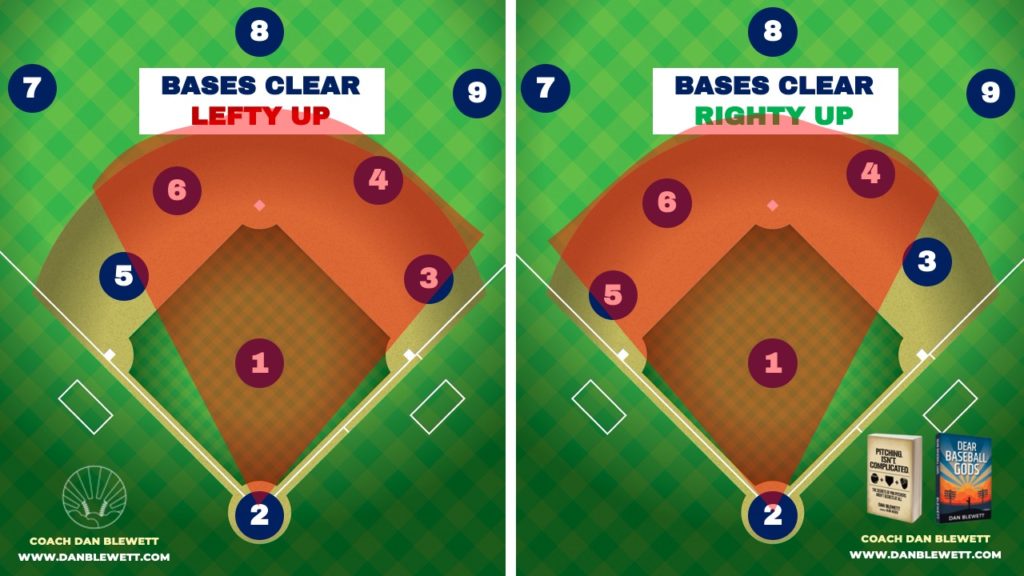
Okay – let’s now get into details on each of the nine positions in baseball.
1. Pitchers (Position #1 on the field chart)
Pitchers have a LOT of influence on the outcome of a game. This video below on pitching mechanics is the most detailed tutorial on the internet, so check it out.
Pitchers have the #1 designation in the baseball scorebook, and they’re in control of the ball and the speed of the game. The following are some of the skills a pitcher needs:
Demands, Skills & Role of a Pitcher
- Strong arm
- Mentally tough
- Able to handle high-pressure situations
- High dexterity and “feel” for throwing a baseball
- Good body control for repeatability of mechanics
- Strong focus and baseball intelligence
- Very competitive
The Pitcher Body Type Scouts Look For
- Tall – the average MLB pitcher is 6’3″ tall
- Long arms and legs
- Strong, thick lower half
- Wide shoulders
- Big forearms can also be a positive indicator
2. Catcher (Position #2 on the field chart)
Catchers have an extremely demanding role on the team – both physically and mentally.
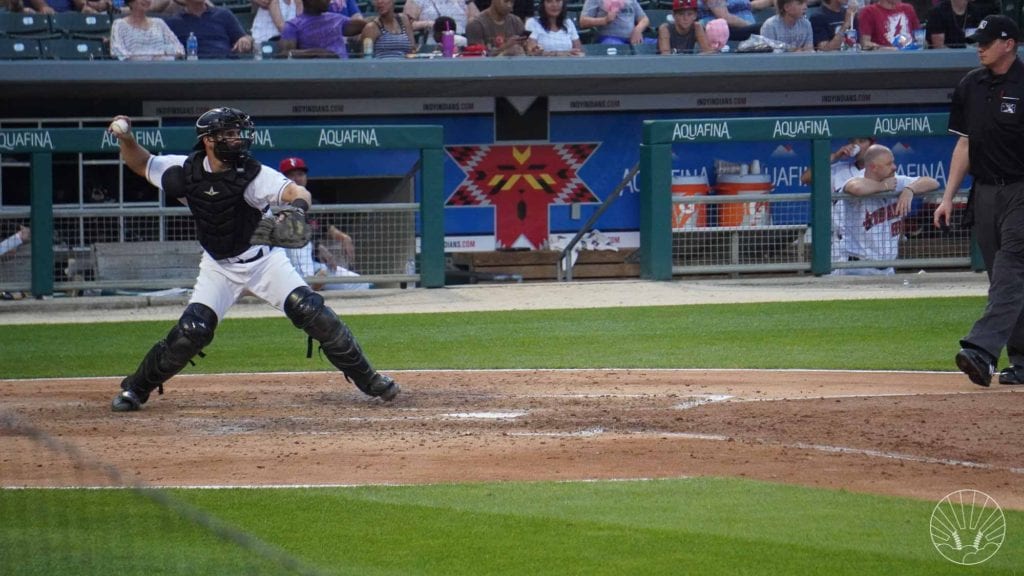
Because the catcher must control and corral the pitcher, he has to be physically and mentally quick. Foul tips and long days squatting and blocking in the heat make for very long, draining days.
Demands, Skills & Role of a Catcher
- The modern MLB catcher is getting taller and more athletic than in the past
- Catchers used to be very thick and could be shorter and less physical, but again – this is changing
- Catchers DO still have strong, thick lower halves, regardless of height
- Hitting skills are a plus and less of a requirement
- Catchers need a very strong arm
- Fast feet and great blocking technique
- Excellent hands and receiving technique
- Very strong and smart mentally
The pop time is very important for a catcher, and I dive into pop times and arm strength in the video below.
The Catcher Body Type Scouts Look For
- Thick, strong and durable
- Taller catchers are becoming more common
- Slightly slimmer, more athletic and agile catchers are becoming more common
- Overall, scouts want to see catchers who are very athletic, strong and agile
3. First Baseman (Position #3 on the field chart)
First baseman are the biggest power hitters on a team, and they are typically very big and relatively slow because of this.
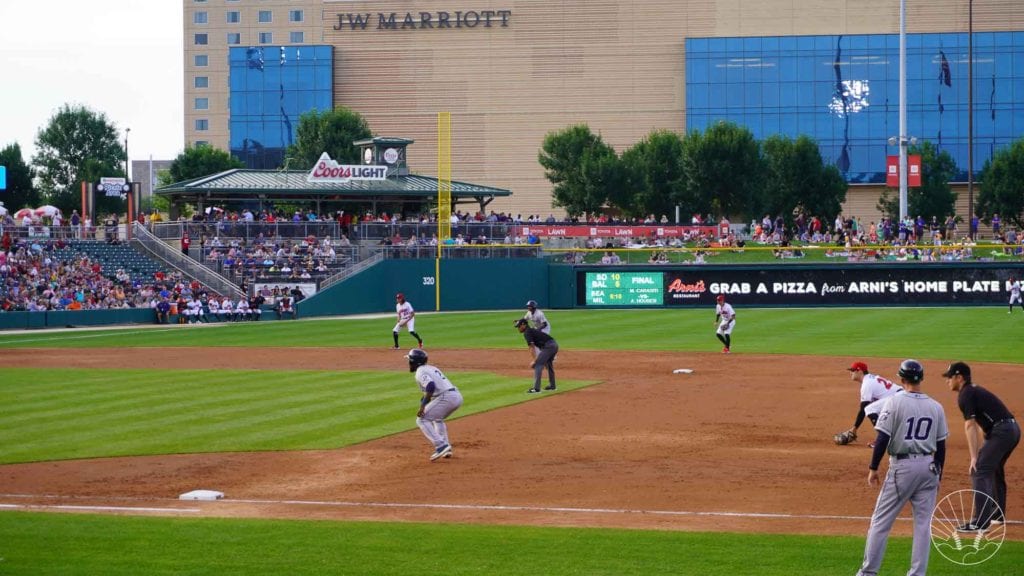
Demands, Skills & Role of a First Baseman
First baseman can often “hide” at first because they don’t often have to make long throws or move around too much. But, that doesn’t mean first base is not a difficult position – it’s easy to play an average first base, but it’s NOT easy to be great at it.
The first baseman is paid to HIT, and hit for power–that’s job #1. Beyond that, he needs to pick bad throws, be a great, large target and read throws well to get outs on every throw he can from other infielders.
Good reflexes and instincts are important, as line drives scream to first base.
The First Base Body Types Scouts Look For
- Left-handed is a plus
- Tall and powerful
- Size matters, speed not so much
- A strong arm is a bonus but not overly important
- Good fielding skills – needs to be able to pick balls and read bad throws
- Quick reflexes – batted balls come to first base HOT
- Small players will NOT get recruited to play in college as a first baseman.
4. Second Baseman (Position #4 on the field chart)
Second baseman are typically great defensive players with the worst bat on the team. Though there are some great-hitting second baseman, it’s typically a less offensive player who excels at 2nd. Dustin Pedroia was an amazing player and a great example.
Demands, Skills & Role of a 2nd Baseman
- Very agile and quick
- Great IQ for the game
- Excellent glove and defensive skills
- Needs an adequate arm, but it doesn’t need to be a cannon
- Should be fast and a skilled contact hitter
- Typically a “spark plug” type player who gets on base and makes things happen on the basepaths
The Second Base Body Type Scouts Look For
Second baseman have to be very quick and agile defenders and have value on the bases. They don’t have to be big and hit for power, so they are often smaller players, usually the only players on the field below 6′ at the pro level.
6. Shortstop (Position #6 on the field chart)
Andrelton Simmons is one of the best defensive shortstops ever, and shows off the athleticism and skill needed to play the position at the highest level.
Shortstops are usually the best athletes on the field at all levels of baseball.
Demands, Skills & Role of a Shortstop
- Must have excellent glove skills
- Excellent range and agility
- Excellent arm strength
- Excellent field vision and understanding of where to go and other players’ movement
- Hitting skills are secondary to defensive ability, however at the MLB level there is a growing importance on being threat at the plate – it’s not enough any more to hit .250 as an MLB shortstop
- Must be mentally tough and have strong leadership skills
Watch the video above on the demands of a shortstop–it’s the hardest position to play in baseball.
The Shortstop Body Type Scouts Look For
- Shortstops are premium athletes and their body types fit this bill
- Most are 5’10-6’2 at the pro level and are fast, explosive, strong and flexible – they can run, jump and do it all
- There cannot be any defensive tool lacking to play at the highest levels – agility, glovework and arm strength must be elite
- Again, the body type is typically lean, strong and powerful –

5. Third Baseman (Position #5 on the field chart)
Third baseman have a similar skillset to shortstops, but they’re typically bigger, stronger and more capable of hitting for power.
Nolan Arenado is a great example of a third baseman who is a threat at the plate and yet also an excellent defender.
Demands, Skills & Role of a Third Baseman
- VERY strong arm to make long throws across the diamond
- Excellent reflexes and is NOT afraid of the ball (they call it the hot corner for a reason)
- Great defender, but lacks the range of a shortstop typically because of bigger physical size
- One of the top power-hitters on the team, typically
- Many high school shortstops who don’t have quite the defensive skills to play SS in college move to third base and pack on some extra muscle
The Third Base Body Types Scouts Look For
- Very strong, athletic and agile but more muscular and strong than a shortstop
- Typically 6′ to 6’3″, strong legs and strong upper body
- Big forearms often indicate to scouts a high level of batspeed and overall strength
What is a 6-4-3 Double Play? (and scoring other plays)
This is a common question, as the “6 4 3 double play” is often referred to on TV broadcasts of games. So, what is it?
Using the number system above for each position, the play is always referred to by the players who touch the ball:
- 6-3 = the shortstop (position #6) got a ground ball and threw to first base (3). This is a type of put out.
- F8 = Fly ball that the centerfielder (position #8) caught.
- 6-4-3 DP = shortstop (6) got a ground ball, threw to the second baseman (4) who then threw to first for a second out (3). So, the double play was created by players 6, then 4, then 3 – 6-4-3 double play.
Using this system, you can look for a record of how every play went down, and sometimes they are very strange when the ball gets thrown away for an error, or other runners take off for the next base after one throw is made. Rundowns, especially, have crazy scorebook references.
Outfielders
First, check out this video I made on outfield defensive positioning – it’s a good overview of things players should know and ways coaches can impact the game.
Keep in mind that the level of play is a big factor in where outfielders will be positioned.
7. Left Fielder (Position #7 on the field chart)
Left fielders typically have an OK arm with a decent glove and a solid bat.
Because more throws from left field aren’t THAT long, they don’t need to have a cannon for an arm.
Demands, Skills & Role of a Left Fielder
Left fielders need to play excellent outfield defense and thus must be fast and have a great glove.
Barry Bonds – the home run king – was a left fielder before becoming a DH.
- Good outfielder, OK arm
- Should have good speed but doesn’t need to be a burner
- Strong bat at the plate
- Typically one of the bigger hitters on the team
The Left Fielder Body Types Scouts Look For
- Big and strong frame
- Typically 6′ to 6’3″ in pro baseball
- Fast, lean and powerful
8. Center Fielder (Position #8 on the field chart)
Mike Trout is perhaps a stronger hitter than most center fielders (he’s a stronger hitter than everyone, but that’s another story…), but he’s still a great example of what a center fielder should be.
Demands, Skills & Role of a Center Fielder
- Must be an excellent fielder – the best defensive outfielder on the team
- Must be exceptionally fast
- Must get great reads and jumps on fly balls
- Arm must be strong
- Must be a solid hitter at the plate and a great base runner to utilize speed
The Center Fielder Body Types Scouts Look For
- Very similar to shortstops – center fielders are one of the best athletes on the team and should look the part
- Must be explosive, lean and strong in a very athletic overall package
- Height isn’t overly important but most center fielders are around 6′ in pro baseball
9. Right Fielder (Position #9 on the field chart)
Right fielders are most commonly known for having rocket launcher arms.
Ichiro was one of the best right fielders ever.
Demands, Skills & Role of a Right Fielder
- At youth levels, the right fielder is one of the lesser players on the team because fewer fly balls are hit that way
- At college and pro levels, the right fielder has one of the strongest arms on the team because of the long throw to third base
- Must hit for power
- Must be an excellent fielder but does not have to be as fast or as amazing in the outfield as the center fielder
The Right Fielder Body Types Scouts Look For
- Right fielders are athletic, big and strong with strong arms
- Typically 6′ to 6’3″ at the pro level with a lot of physicality – size and strength
- Corner outfielders need to have power at the plate while still being agile and fast in the outfield
The Three Main Types of Baseball Position Players
In this video below, you’ll find the three “bins” I put players in according to the positions they should be playing and their skills and body types.
Other Positions: DH + Roles of Pinch Runner, Pinch Hitter
What is the DH in baseball? The Designated Hitter is a player who only hits, and this position exists only in the American League. The DH hits in place of the pitcher, who does not bat in the American League.
Pinch Runners enter the game to run the bases in place of another player, but this is not really a position – more just a role. Same goes for pinch hitters, who replace a hitter already in the game to bat for them.
Common Mistakes Made By Players & Parents in Choosing a Position
What position is right for a young player?
What can help a young player reach the next level?
Common mistakes can really hold a player back, no matter the position he plays.
Mistake #1: Aspiring to excel in a position that just isn’t a good fit
Many players dream of playing shortstop in college, but they just aren’t agile enough or throw hard enough across the diamond.

Other players dream of being a first baseman and love the position – but they’re too small and don’t hit the longball nearly often enough.
As players and parents, making informed decisions on your path in baseball is key, and being honest with oneself is an important part of this process. If you’re just not going to be physically big enough to play first base at a high level…then start practicing other positions that might prove a better fit.
Mistake #2: Being too rigid about position
Some players have the mindset of “I’m a shortstop” or “I play center field.”
It’s great to love a position and pride oneself on playing it well, but at the high school and college levels, there are often very successful starters already playing those positions. If the starting shortstop on Varsity is a great player, then being too rigid and not willing to play another position can mean that sitting on the bench is the only other option.
Be flexible and willing to try other positions, because your favorite one may not always be available.
Mistake #3: Playing too many positions
I also see players and parents fall into the trap of playing too many positions at the high school level, where scouts may not be sure where they fit in.
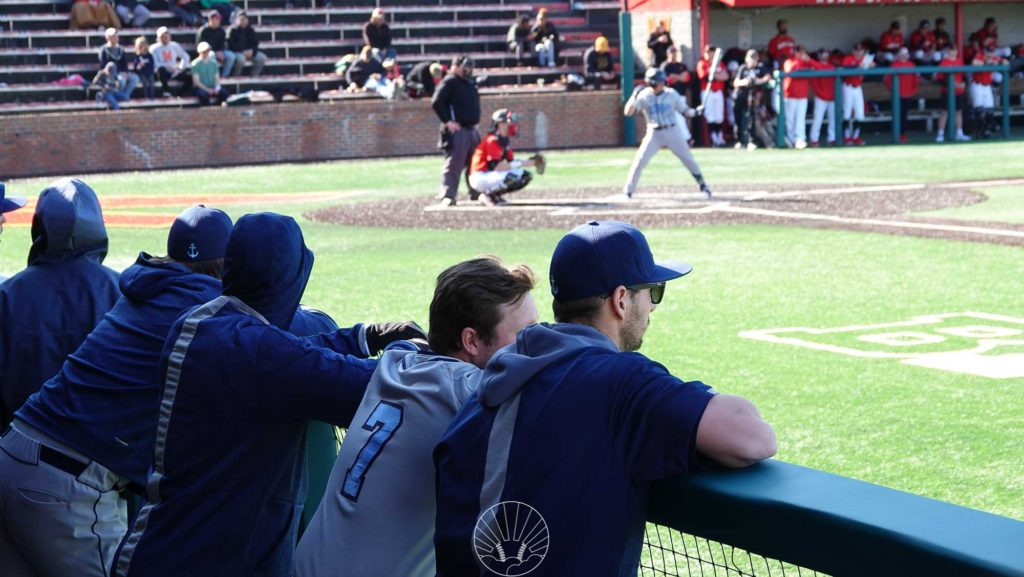
Being versatile is a great thing and having utility in more than one position can help a player.
But playing too many positions with average skill is NOT better than playing 1-2 positions with a high level of skill.
More Baseball Resources
- Subscribe to my YouTube Channel
- Read My Article on Pitching Mechanics
- My Article on How to Throw a Curveball
- My Article on How to Throw a Changeup
- Read all About Balks – The Rules & How to Avoid Them
- College Recruiting: Should You Go JUCO?
And grab a copy of my book below.

I hope you enjoyed this article – keep learning!
FAQ – Common Questions About Positions in Baseball
What baseball position is hardest?
This answer is highly subjective baseball the positions take different levels of skill and athleticism, but a few positions stand out: pitcher, catcher, shortstop and centerfielder. The shortstop has to be the combination of the best fielder, thrower and mover (meaning great footwork and range) of all the infielders. The center fielder has to cover the most ground in the outfield, so he has to be the best fielding outfielder and is typically the fastest player on the team. But, the centerfielder doesn’t have to be a big hitter to stay in the lineup. The catcher has a very demanding, physically difficult position that also requires lots of mental toughness, and the pitcher is subject to high injury risk and needs high levels of skill, explosiveness, mental toughness and intelligence to get high-level hitters out.
What position in baseball has the strongest arm?
The typical answer for this is the right fielder, because they will have the longest throw to third base of all outfielders. However, it’s not really the case any more that they have the strongest arm on the entire team–they might–but the shortstop and third baseman also have tremendously strong arms. Aside from the pitcher, the strongest arm probably belongs to either the third baseman or right fielder, though it is never a firm rule and varies by team.
Which position player is the fastest?
Typically the centerfielder, who is usually a slightly slimmer-built player who can cover lots of ground in the outfield. But, in modern baseball the shortstop and second baseman are often very fast as well. Right and left fielders typically have moderate speed.
What is the easiest position in baseball?
Right field, and the reason is that because 80% of hitters are right-handed, fewer fly balls will go to right field. Most hitters like to pull the ball and pull the ball when they are fooled by offspeed pitches. So more fly and ground balls go to the left field of the field, meaning fewer chances are sent out to the right fielder. In amateur baseball fewer right handed hitters have the power to send deep fly balls to the opposite field (which would be to Right), and thus again there are fewer fielding chances because of this.
Why is the shortstop #6 and not #5?
This was because originally, in the early days of baseball, the shortstop was the fourth outfielder. Later, the shortstop was moved permanently to the infield but his number stuck at #6.
Why are catchers not left-handed in baseball?
Because the throw to third base is very difficult with a right-handed hitter in the batters’ box, and stealing third is a critical play in baseball. However, softball (even at the Division-I level) features occasional lefty catchers and they seem to do okay.
Why can’t the third baseman, shortstop or second baseman be left-handed?
Because as they charge ground balls and throw to first or second base, a lefty infield throw would require a complete reversal of the hips and footwork to make proper throws. For a lefty, this would take too much time and high-level runners would beat out infield hits more often. Right handed infielders exclusively play third, short and second because all throws to second and first are natural with regards to their footwork and hip positioning, thus allowing them to quickly make strong throws at all angles across the diamond.
What do the baseball position numbers mean for scoring?
They just make the game a lot easier to score – the numbers represent all the individual positions and make the scorebook keeper’s job much simpler.
